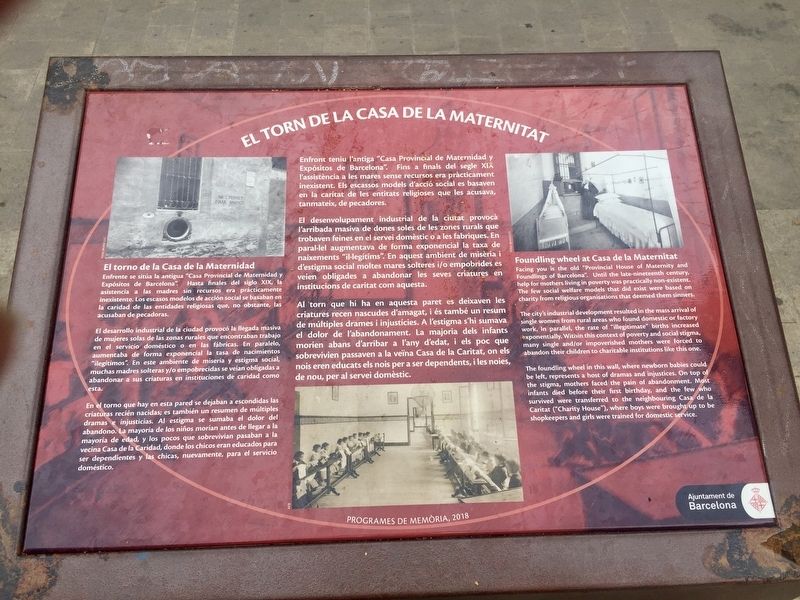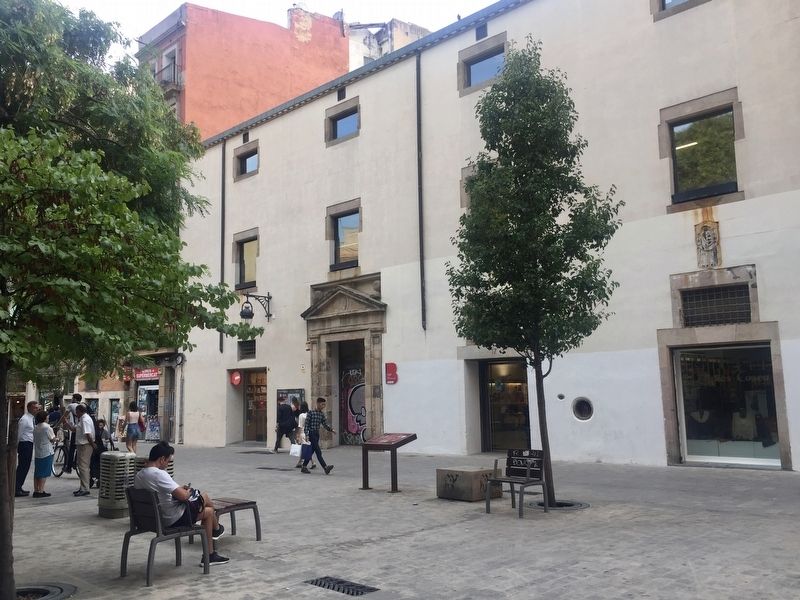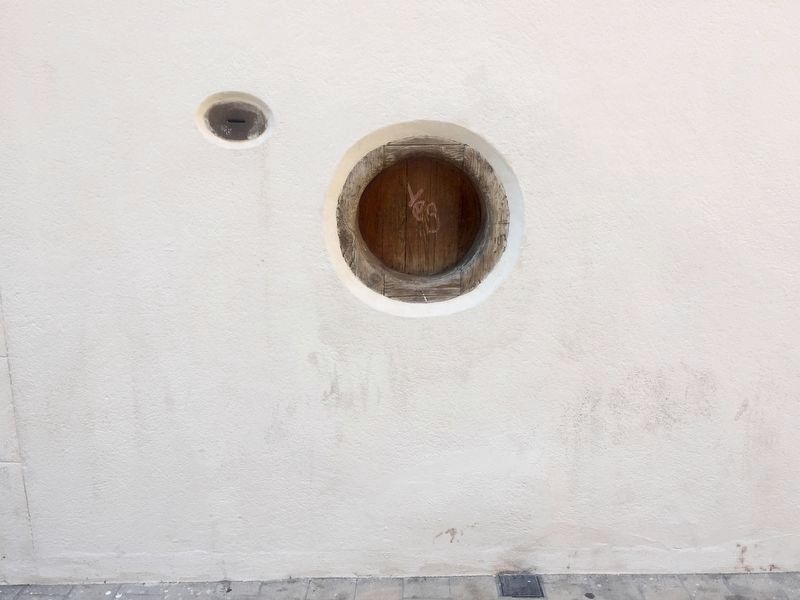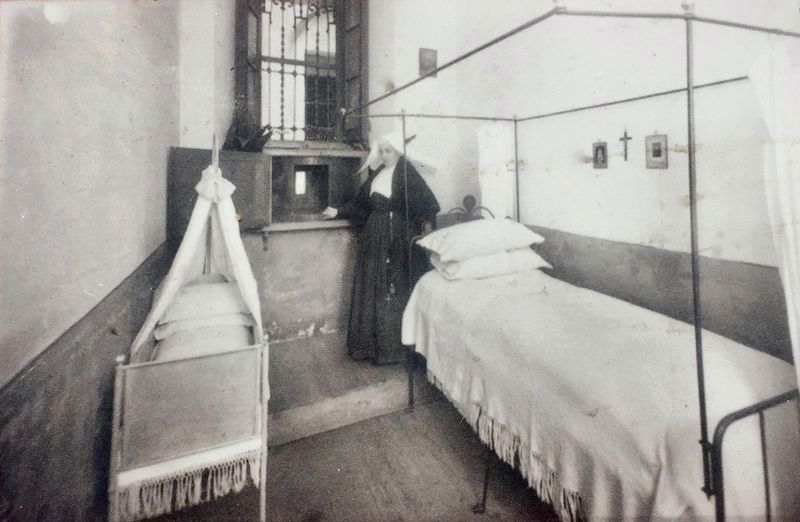El Raval in Barcelona, Catalonia, Spain — Southwestern Europe (Iberian Peninsula)
El Torno / El Torn / The Foundling Wheel
Inscription.
(Spanish:)
Enfrente se sitúa la antigua "Casa Provincial de Maternidad y Expósitos de Barcelona". Hasta finales del siglo XIX, la asistencia a las madres sin recursos era prácticamente inexistente. Los escasos modelos de acción social se basaban en la caridad de las entidades religiosas que, no obstante, las acusaban de pecadoras.
El desarrollo industrial de la ciudad provocó la llegada masiva de mujeres solas de las zonas rurales que encontraban trabajo en el servicio doméstico o en las fábricas. En paralelo, aumentaba de forma exponencial la tasa de nacimientos "ilegítimos” En este ambiente de miseria y estigma social, muchas madres solteras y/o empobrecidas se veían obligadas a abandonar a sus criaturas en instituciones de caridad como esta.
En el torno que hay en esta pared se dejaban a escondidas las criaturas recién nacidas; es también un resumen de múltiples dramas e injusticias. Al estigma se sumaba el dolor del abandono. La mayoría de los niños morían antes de llegar a la mayoría de edad, y los pocos que sobrevivían pasaban a la vecina Casa de la Caridad, donde los chicos eran educados para ser dependientes y las chicas, nuevamente, para el servicio doméstico.
-
(Catalan:)
Enfront teniu l'antiga "Casa Provincial de Maternidad y Expósitos de Barcelona". Fins a finals del segle XIX l'assistència a les mares sense recursos era pràcticament inexistent. Els escassos models d'acció social es basaven en la caritat de les entitats religioses que les acusava, tanmateix, de pecadores.
El desenvolupament industrial de la ciutat provocà l'arribada masiva de dones soles de les zones rurals que trobaven feines en el servei domèstic o a les fabriques. En paral-lel augmentava de forma exponencial la taxa de naixements "il-legitims". En aquest ambient de misèria i d'estigma social moltes mares solteres i/o empobrides es veien obligades a abandonar les seves criatures en institucions de caritat com aquesta.
Al torn que hi ha en aquesta paret es deixaven les criatures recen nascudes d'amagat, i és també un resum de múltiples drames i injustícies. A l'estigma s'hi sumava el dolor de l'abandonament. La majoria dels infants morien abans d'arribar a l'any d'edat, i els poc que sobrevivien passaven a la veina Casa de la Caritat, on els nois eren educats els nois per a ser dependents, i
les noies,
de nou, per al servei domèstic.
-
The Foundling Wheel at Casa de la Maternitat
Facing you is the old "Provincial House of Maternity and Foundlings of Barcelona". Until the late-nineteenth century, help for mothers living in poverty was practically non-existent. The few social welfare models that did exist were based on charity from religious organisations that deemed them sinners.
The city's industrial development resulted in the mass arrival of single women from rural areas who found domestic or factory work. In parallel, the rate of "illegitimate" births increased exponentially. Within this context of poverty and social stigma, many single and/or impoverished mothers were forced to abandon their children to charitable institutions like this one.
The foundling wheel in this wall, where newborn babies could be left, represents a host of dramas and injustices. On top of the stigma, mothers faced the pain of abandonment. Most infants died before their first birthday, and the few who survived were transferred to the neighbouring Casa de la Caritat ("Charity House"), where boys were brought up to be shopkeepers and girls were trained for domestic service.
Erected 2018 by Ajuntament de Barcelona, Programes de Memòria.
Topics and series.
This historical marker is listed in these topic lists: Charity & Public Work • Women. In addition, it is included in the Barcelona Programes de Memòria series list.
Location. 41° 23.051′ N, 2° 10.123′ E. Marker is in Barcelona, Cataluña (Catalonia). It is in El Raval. Marker is on Carrer de les Ramelleres just north of Carrer d'Elisabets, on the left. Touch for map. Marker is at or near this postal address: Carrer de les Ramelleres, 7, Barcelona, Cataluña 08001, Spain. Touch for directions.
Other nearby markers. At least 8 other markers are within walking distance of this marker. "La Solidaridad" (about 90 meters away, measured in a direct line); Roberto Bolaño Ávalos (about 90 meters away); Joaquim Serra i Corominas (about 90 meters away); Jaume Fuster Birthplace (about 150 meters away); Rómulo Gallegos (about 180 meters away); Andreu Nin (about 210 meters away); Roman Sepulchral Way and Vila de Madrid Square (approx. 0.3 kilometers away); Portaferrissa - La "Porta Ferriça" / Portaferrissa - The Iron Gate (approx. 0.3 kilometers away). Touch for a list and map of all markers in Barcelona.
Also see . . .
1. Baby Hatch (Wikipedia). "A baby hatch or baby box is a place where people (typically mothers) can bring babies, usually newborn, and abandon them anonymously in a safe place to be found and cared for. This kind of arrangement was common in the Middle Ages and in the 18th and 19th centuries, when the device was known as a foundling wheel. Foundling wheels were taken out of use in the late 19th century but a modern form, the baby hatch, began to be introduced again from 1952 and since 2000 has come into use in many countries, notably in Germany, where there are around 100 hatches and in Pakistan where there are more than 300 as of 2006." (Submitted on October 24, 2019.)
2. The Foundling Wheel at Plaça de Viçenc Martorell (Barcelona Lowdown). "A common feature of orphanages and convents of the time was a rotating wooden turntable called a foundling wheel where parents could leave new-born babies that they were unable to care for....On the other side of the hatch was small room with a cot and a bed where a nun slept, ready to take care of the newly abandoned infants. There is a small slot next to the hatch for donations to help support the orphanage.... The foundling wheel at Plaça de Viçenc Martorell was in use from 1853 until 1931. During this time it received hundreds, if not thousands, of orphans. The nuns who ran the orphanage renamed the children, giving them the name of a Catholic saint and the surname Expósito." (Submitted on October 24, 2019.)
Additional keywords. orphanage
Credits. This page was last revised on February 3, 2023. It was originally submitted on October 23, 2019, by Andrew Ruppenstein of Lamorinda, California. This page has been viewed 319 times since then and 39 times this year. Photos: 1, 2, 3, 4. submitted on October 24, 2019, by Andrew Ruppenstein of Lamorinda, California.



